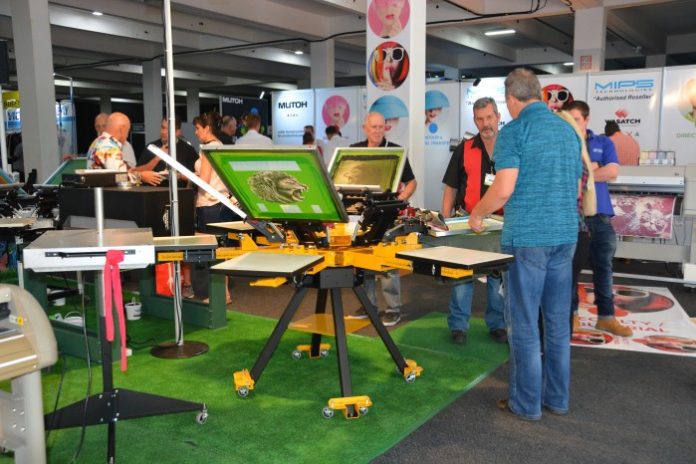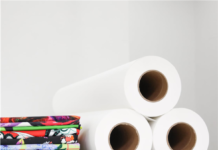In this series, expert Charlie Taublieb from Taublieb Consulting explains the basics of screen printing, from job carts all the way to press breakdown. Much of this information is for automatic presses. With a manual press, users should disregard the areas that deal with flood bars. This article appears in the Sign Africa Journal.
JOB CART USAGE
Check paperwork to make sure you are putting the correct products on the cart. Make sure the top of the cart and where the screens slide in are clean.
1. Carefully slide in screens starting at the top and working down.
2. Place the ink needed on the top.
3. Place the appropriate squeegees and floodbars on top.
As the clean screens are removed from the top the dirty screens are loaded starting at the bottom. Dirt squeegees and floodbars that are not needed for the next job are placed on the top of the cart.
PROCEDURES FOR HANDLING SCREENS IN THE SHOP
- All screens get put on the screen rack.
- Add ink into all the screens.
- Remove an entire job from the rack and set it up.
- Once the job is done card out the excess ink and put the screens into the bottom of the screen rack.
- If the next job uses some of the same colours, keep the squeegee(s), otherwise put the squeegee(s) going into the screens on the rack.
- Do not clean the screen(s) or squeegee(s).
- Take the next job off the cart and set it up.
SETUP PROCEDURES FOR NEW REGISTRATION SYSTEM
- ‘0’ out all micros.
- Put all screens into the screen holders, making sure the screen is towards the centre, far enough so the squeegee can print all registration marks.
- Spray pallet #1 with adhesive.
- Lay the lineup template on the pallet, making sure it is square to the pallet.
- Move to the first colour and register the three registration marks.
- Register all the screens to the registration marks.
- Put a pellon/test square on pallet #2.
- Print the base colour (the one with the most detail). Usually it will be the white underlay for dark coloured garments and black outline for light coloured garments.
- Cover the design with clear packing tape. It is not necessary to flash before covering the design.
- Go to the first colour and print it on top of the packing tape.
Check the print to see if it is in register. If not, wipe off the ink, make the adjustment and print again. Repeat until the registration is correct. - Once registered, clean off the ink and move to the next screen.
- Repeat procedure from #10 and #11. Continue until all screens are registered.
- Tape off registration marks.
- Print a test shirt to make sure everything is in register.
Print the job.
PRESS SETUP PROCEDURES: TWO OPERATORS ON ONE PRESS
Make sure all micros are ‘0’ out:
- Operator #1 gets the cart with the next job on it and brings it to the press unless it is already at the press.
- Operator #1 sets screens into the screen holders making sure to move all screens as far forward as necessary so the registration marks are able to be printed. Make sure the floodbar doesn’t stop on the print but floods past it or a line may develop.
- Operator #2 attaches the registration template to pallet #1 .
- Operator #2 starts the new registration setup procedures.
- Once all screens are in place operator puts squeegees and floodbars on for the screens that operator #2 has registered.
- Operator #2 adds ink to the screen that will be used to check the registration, prints the pellon/test square and covers the print with clear tape.
- While operator #2 is setting up the first screen, operator #1 adds ink to all screens, making sure not to get any in the image area.
- Operator #2 registers all the screens.
- As each screen is registered operator #1 tapes out the registration marks.
- Once all registration marks are taped out, a sample shirt is printed and checked. Once approved the job is printed.
- While the sample shirt is being printed operator #1 brings the cart back to the ink area.
PRESS SETUP PROCEDURES: THREE OPERATORS WORKING ON ONE PRESS
Make sure all micros are ‘0’ out.
- Operator #3 gets the cart with the next job on it and brings it to the press unless it is already at the press.
- Operator #3 sets screens into the screen holders, making sure to move all screens as far forward as necessary so the registration marks are able to be printed. Make sure the floodbar doesn’t stop on the print but floods past it or a line may develop. Put screens in starting at the last station and work towards the first one.
- Operator #2 attaches the registration template to pallet.
- Operator #1 starts the registration setup procedures.
Once all screens are in place operator #2 and operator #3 puts squeegees and floodbars on for the screens that operator #1 has registered. - Operator #2 adds ink to the screen that will be used to check the registration, prints the pellon/test square and covers the print with clear tape.
- While operator #2 is setting up the first screen, operator #3 adds ink to all screens, making sure not to get any in the image area.
- Operator #1 registers all the screens.
- As each screen is registered, operator #2 tapes out the registration marks. Once all registration marks are taped out, a sample shirt is printed and checked. Once approved, the job is printed.
- Once all registration marks are taped out, a sample shirt is printed and checked. Once approved the job is printed.
- While the sample shirt is being printed operator #3 brings the cart back to the staging area.
BREAKDOWN
Once the last shirt is printed and counted and the job is complete, the following takes place:
SEQUENCE ONE
- Operator #3 gets the next job cart unless it is already at the press.
- Operator #1 removes the squeegees starting with the first screen.
- Operator #2 follows removing the floodbars. When the squeegees and floodbars are removed, they are put on the job cart.
- Operator #3 starts to remove the screens and place them in the cart.
- Operator #2 puts the used ink from the finished job on the cart and removes the ink that is needed for the new job.
- Operator #1 starts the setup procedure.
SEQUENCE TWO
- Operator #1 gets the next job cart unless it is already at the press.
- Operator #1 removes the squeegees starting with the first screen.
- Operator #2 follows removing the floodbars. When the squeegees and floodbars are removed, they are put on the job cart.
- Operator #2 starts to remove the screens and place them in the cart.
- Operator #1 puts the used ink from the finished job on the cart and removes the ink that is needed for the new job.
- Operator #1 starts the setup procedure.
Sign Africa Journal www.signafrica.com/magazine















